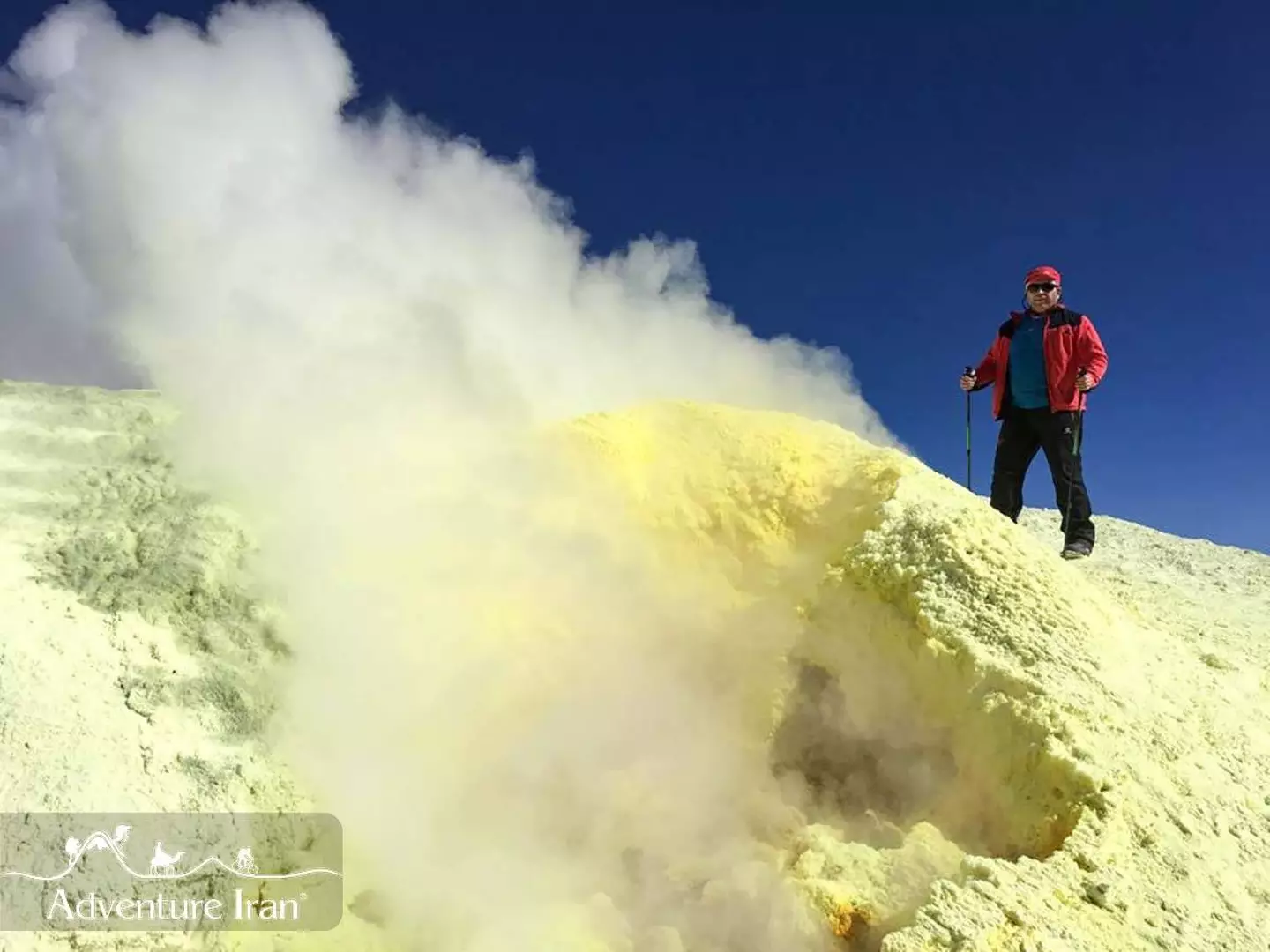
'Zombie' volcano believed to be extinct for 710,000 years now showing signs of life
There's another warning to add to your disaster alert list, with a supposedly dormant volcano in southeast Iran showing signs of life. The unusual thing about this particular mountain of molten lava is that it's been quiet for the past 710,000 years and was presumed dead. Now, this 'zombie' volcano is rumbling to life and is in danger of crawling out of its grave.
2025 has been a big one for volcanoes, with Hawaii's Kīlauea Volcano spewing lava, visitors being forced to flee down the slopes of Mount Etna, and fears that the Ring of Fire volcanoes could erupt in a deadly chain reaction. The legendary Nostradamus seemingly predicted Mount Etna blowing its top in 2024 or 2025, but have we been underestimating Iran's Mount Taftan?
With scientists warning that 'hundreds' of dormant volcanoes could be ready to erupt, Mount Taftan is making moves.
Volcanoes are classed as extinct if they haven't erupted since the Holocene Era that started 11,700 years ago, meaning Mount Taftan was considered well and truly deceased.
Local reports in 2024 noted increased activity, like visible smoke and ash bubbling from the center of the crater, which is now said to be worsening.
Speaking to Live Science, volcanologist Pablo González has reiterated that we should consider Mount Taftan dormant instead of extinct: "Our findings reveal that Taftan is more active than previously recognized.”

There’s an urgent need to reassess the Makran subduction volcanic arc, which is a volcano chain that spans Iran and Pakistan. Notably, Taftan’s activity suggests that hazard evaluations might be ‘outdated’.
Even though it's not currently erupting, pressure is supposedly building under the ground of Mount Taftan and is in danger of bursting out violently in the future.
Over the past 10 months, the Mount Taftan summit has been releasing water vapor, carbon dioxide, sulfur dioxide, hydrogen sulfide, and hydrogen fluoride. Sulfur dioxide emissions are currently averaging 20 tons every day.
Two larger gas events occurred on May 16 and 28 in 2024, although the latest findings were reported by a new satellite data method. The common-mode filter removes atmospheric interference and gives a much clearer picture of what's going on with the volcano.
Mount Taftan's western and eastern flanks have moved, but with the pattern of deformation not matching rainfall or earthquakes, González's team is adamant it was caused by what's going on inside the volcano. The study reiterates: "The absence of post-unrest reversed subsidence signals highlights the potential for persistent pressurization beneath the summit, suggesting that the Taftan volcano remains a hazardous area."
Putting some of our fears to rest, González says there are no signs of an immediate eruption, adding that the study "doesn't aim to produce panic in the people." Instead, he said it's "a wake-up call to the authorities in the region in Iran to designate some resources to look at this."
The stratovolcano can be found in Iran's Sistan and Baluchestan province, near the Pakistan border.
Towering at 13,000 feet above sea level, it's the highest peak in the region and can be clearly seen by the Iranian city of Khash, which is 81 miles away. Other 'nearby' cities include the provincial capital of Zahedan (with a population of half a million), which lies 100 miles away.
We're told that if Mount Taftan erupts, communities could be greatly affected by ashfall, contaminated water supplies, and long-term fallout like crop damage and respiratory issues.
Even if González isn't worried for now, he says we need to keep a close eye on the volcano.
News in the same category


Growing Concern Over Visceral Fat — Doctors Recommend 9 Foods to Help Burn It Naturally

‘This Is An Opportunity For You To Get Some Portal Film’ | Deion Sanders’ Ruthless Scrimmage Urging Bench Players To Transfer Angers Fans

Texas Cheerleader Jumps Off Homecoming Float To Save Choking Toddler

Meet Andrea Walls, the Artist Preserving Black Stories Through Photography

5 Tasty Eating Habits That Could Be Silent Cancer Risks for the Whole Family — Avoid Them Now

Do You Need to Unplug Your Rice Cooker After the Rice Is Done?

K Hospital Issues Warning: Daily Consumption of Processed Meats May Increase Cancer Risk – Don’t Ignore It!

5 Warning Signs of Fish Preserved with Urea – Don’t Take It Home Even If It’s Free

Eating Chicken with Sticky Rice Is a Mistake: 5 Classic Food-Combining Errors That 9 out of 10 People Don’t Know

Three Optimal Times to Drink Perilla Leaf (Lá Tía Tô) Tea—And Most People Don’t Know Them

Single Dad Adopts 5 Siblings Under The Age Of Six So They Can Stay Together

21 Year Old Hotel Employee Who Managed 90 Guests Alone During Tropical Storm Is Gifted New Car

Texas Southern University Debate Team Wins 5th World Championship Title

Meet Faith Couch, the Photographer Transforming the Way We See Black Love

People mind-blown by futuristic 'doll house' neighborhood in China home to over 1,000 units

Incredible story of teen who survived 49 days lost at sea on floating fish trap

YouTuber uncovers hidden city under water that's been missing for almost 100 years

The Secret to Perfectly Sweet and Fluffy Boiled Sweet Potatoes: Add Just One Spoon of This!
News Post

Put a bowl of salt in the refrigerator: A small but effective tip that makes me regret knowing it after 30 years

Most Attractive Hobby a Man Can Have According to Women

The Hidden Power of the Hole in Your Kitchen Knife — 7+ Surprising Uses You Probably Didn't Know

Most people will go their entire lives without ever knowing what the microwave ring cover is actually for

10 Morning Habits That Are Surprisingly Harmful to Your Health

6 Effective Drinks to Help Prevent Stroke – Don’t Overlook These Choices

DENTISTS HATE HOW SIMPLE THIS TEETH WHITENING HACK IS

Juniper: A Comprehensive Guide to Its Benefits and Uses

Unveil Colgate’s Secret for Silky-Smooth Feet

Evergreen Huckleberry (Vaccinium ovatum) – Benefits, Uses, and Growing Guide

A 3-Year-Old Boy Got Super Glue in His Eye — His Mother’s “Golden 30 Seconds” Saved His Sight

Growing Concern Over Visceral Fat — Doctors Recommend 9 Foods to Help Burn It Naturally

7 Amazing Health Benefits of Banana Blossoms

Bryophyllum Calycinum (Kalanchoe Pinnata): Benefits and Uses

Purslane: The Superfood That Tastes Better Than Meat – 7 Reasons to Grow It in Your Garden

7 Benefits of Chewing Raw Garlic on an Empty Stomach

Chayote Remedy: Natural Cure for Pain, Swelling, Blood Pressure & Cholesterol

Alkaline Water – Recipe and Health Benefits for Skin & Hair

Garlic, Honey, and Cloves – a powerful natural remedy packed with health benefits
